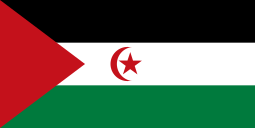Dinosaurs-on-Stamps
| |
 |
|
 |
|
| |
Sahrawi |
and |
Moroccan Sahara |
|
The Sahrawi Arab Democratic Republic (SADR), is a partially recognized state, which claims the non-self-governing territory of Western Sahara, but controls only the easternmost one-third of that territory.
Between 1884 and 1975, Western Sahara was known as Spanish Sahara, a Spanish colony (later an overseas province).
Western Sahara has been on the United Nations list of Non-Self-Governing Territories since 1963 following the transmission of information on Spanish Sahara by Spain under Article 73(e) of the Charter of the United Nations.
In 1975, Spain decided to allow Mauritania and Morocco to partition and occupy the Territory of the Sahara.
On February 26, 1976, the Permanent Representative of Spain to the United Nations informed the Secretary-General that
"the Spanish Government, as of today, definitely terminates its presence in the Territory of the Sahara and deems it necessary to place the following on record: . . . that Spain considers itself henceforth exempt from any responsibility of an international nature in connection with the administration of the said Territory, in view of the cessation of its participation in the temporary administration established for the Territory."
On February 27, 1976, a locally based Sahrawi national liberation movement, known as the Polisario Front, initiated a guerrilla war, with significant financial and logistical support from Algeria and Libya.
The Polisario Front proclaimed the official country name as the Sahrawi Arab Democratic Republic.
The United Nations considers the Polisario Front to be the legitimate representative of the Sahrawi people.
Mauritania was forced to relinquish its claim over Western Sahara in 1979 and the Polisario Front continued its military campaign against Morocco until a 1991 ceasefire.
The United Nations Mission for the Referendum in Western Sahara (MINURSO) was established by Security Council resolution 690 on April 29, 1991, in accordance with settlement proposals accepted on August 30, 1988, by Morocco and the Polisario Front.
The UN-backed referendum has been consistently postponed ever since.
The settlement plan, as approved by the Security Council, provided for a transitional period for the preparation of a referendum in which the people of Western Sahara would choose between independence or integration with Morocco.
The Special Representative of the Secretary-General was to have sole and exclusive responsibility over matters relating to the referendum and was to be assisted in his tasks by an integrated group of civilian, military and civilian police personnel.
The SADR government calls the territories under its control the Liberated Territories or the Free Zone. Morocco controls and administers the rest of the disputed territory, and calls these lands its Southern Provinces, aka. Moroccan Sahara.
The claimed capital city of the SADR is El-Aaiún (Laȃyoune), the former capital of Western Sahara.
Since SADR does not control El-Aaiún, it has a temporary capital in Tifariti.
In 2020 the Polisario Front declared the ceasefire over and resumed the armed conflict.
The Polisario Front is outlawed in the parts of Western Sahara under Moroccan control, and it is illegal to raise its party flag (often called the Sahrawi flag) there.
The SADR maintains diplomatic relations with 46 UN states, and is a full member of the African Union.
With a population of about half a million, it is the most sparsely populated area of Africa.
Maintained by Robert Margulski;
E-Mail your comments to: RLM07@Margulski.name



